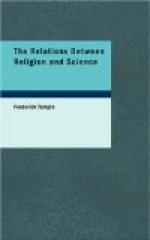Granting then the high probability of the two theories of Evolution, that which begins with Laplace and explains the way in which the earth was fitted to be the habitation of living creatures, and that which owes its name to Darwin and gives an account of the formation of the living creatures now existing, we have to see what limitations and modifications are necessarily attached to our complete acceptance of both.
First, then, at the very meeting point of these two evolutions we have the important fact that all the evidence that we possess up to the present day negatives the opinion that life is a mere evolution from inorganic matter. We know perfectly well the constituents of all living substances. We know that the fundamental material of all plants and all animals is a compound called protoplasm, or that, in other words, organic matter in all its immense variety of forms is nothing but protoplasm variously modified. And we know the constituent elements of this protoplasm, and their proportions, and the temperatures within which protoplasm as such can exist. But we are quite powerless to make it, or to show how it is made, or to detect nature in the act of making it. All the evidence we have points to one conclusion only, that life is the result of antecedent life, and is producible on no other conditions. Repeatedly have scientific observers believed that they have come on instances of spontaneous generation, but further examination has invariably shown that they have been mistaken. We can put the necessary elements together, but we cannot supply the necessary bond by which they are to be made to live. Nay, we cannot even recall that bond when it has once been dissolved. We can take living protoplasm and we can kill it. It will be protoplasm still, so far as our best chemistry can discover, but it will be dead protoplasm, and we cannot make it live again; and as far as we know nature can no more make it live than we can. It can be used as food for living creatures, animals or plants, and so its substance can be taken up by living protoplasm and made to share in the life which thus consumes it; but life of its own it cannot obtain. Now here, as it seems, the acceptance of the two evolutions lands us in acceptance of a miracle. The creation of life is unaccounted for. And it much more




